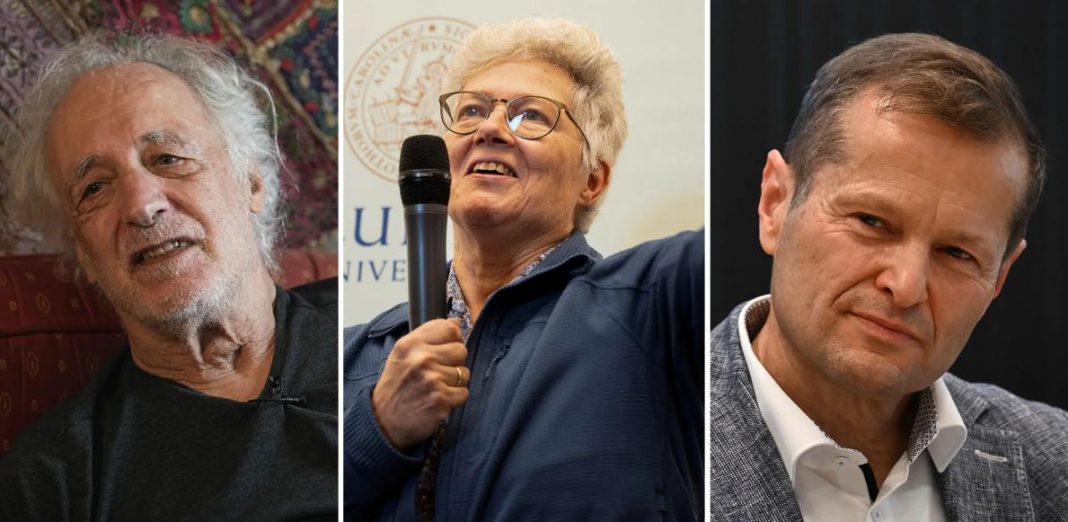On Tuesday, Pierre Agostini, Ferenc Krausz, and Anne L’Huillier were awarded the Nobel Prize in Physics for their work developing methods to shed light on the subatomic world of electrons.
The speed of an electron is an incredible 43 miles per second. Their speed has long rendered them unstudable. The innovative experimental techniques developed by the three Nobel laureates capture the motion of an electron in a single instant by use of brief light pulses.
Imagine a fan spinning at full speed: the individual blades become indistinguishable. A strobe light, however, will illuminate a still image of the fan with each flash. The shorter the flashes grow, the more we learn about the fan.
Scientists had to utilise light pulses lasting just attoseconds to examine electron motion; an attosecond is one quintillionth of a second. The Royal Swedish Academy of Sciences (which also hands out the Nobel Prizes) estimates that the amount of attoseconds in a single second is equal to the sum of all the seconds that have passed since the cosmos exploded into existence 13.8 billion years ago.
In her role as head of the Nobel Committee for Physics, Eva Olsson stated on Tuesday at a news conference that attosecond science “allows us to address fundamental questions” by measuring the relative locations of electrons in an atom.
By examining what happens when a powerful laser is shone through noble gases in 1987, Dr. L’Huillier paved the way for future research at the electron level. Noble gases are odourless, colourless, single-atom gases with negligible chemical reactivity. She found that the laser pumped up the gas, causing it to give forth light at specific frequencies.
Light is an electromagnetic wave with peaks and valleys whose heights and depths are proportional to its frequency. As they move, these waves bump against one another, amplifying their effects, and cancelling one another out when their peaks coincide. The research of Dr. L’Huillier has shown that it is possible for these waves to align in such a way as to generate brief bursts of light that may be used to examine electrons.
Before Dr. Agostini successfully demonstrated a way to make a sequence of light pulses lasting 250 attoseconds in 2001, scientists were unsure of how to combine these waves or analyse such brief pulses. Dr. Krausz created a single light pulse lasting 650 attoseconds using a different method. Developments down the line have allowed for pulse durations of a few dozen attoseconds.
This subatomic “strobe light” allows scientists to get a picture of the atomic mechanism. While this effect won’t provide any visuals, it will show where electrons are in relation to one another and how long it takes to move them away from the nucleus in an atom or molecule. With the use of attosecond physics, researchers will be able to determine how long it takes for an object’s electrons to leave after being struck by light. The hypothesis of this phenomena, known as the photoelectric effect, was established by Albert Einstein in 1921, and he was awarded the Nobel Prize in Physics for his efforts.
Gaining insight into the ultrafast realm of electron mobility may potentially pave the way for more effective circuits, drugs, battery materials, and noninvasive diagnostic instruments.
Ohio State University physicist Louis DiMauro praised Dr. L’Huillier’s contributions as a series of “elegant experiments and superb theory” that paved the way for the possibility of electron motion capture. This revolutionary dream, he claimed, had been in the works for decades, but it wasn’t until doctors Agostini and Krausz followed the difficult prescription that it became a reality.
Theoretical physicist at the Max Planck Institute of Quantum Optics and Dr. Krausz’s colleague Ignacio Cirac noted in an email that the finding gives physicists with “a new tool to tame the microscopic world.”
According to Jan-Michael Rost, director of the Max Planck Institute for the Physics of Complex Systems, these “stroboscopic images of electrons, like of dancers in a club,” have “sparked the creativity” of researchers across the world.
Dr. Krausz received a call when he was at home, preparing for a physics lecture. “I just wasn’t sure whether I’m dreaming or whether it’s reality,” he explained. Those who “have directly or indirectly contributed to this,” he continued, were at the forefront of his mind.
Since Pierre Agostini was in Paris when the news was made, the Nobel Foundation was unable to contact him. Dr. Agostini was told of the victory by his daughter, who called to verify if the rumour was real. His initial reaction to his sudden notoriety was to say, “I thought it was some kind of mistake, but it’s not,” and then he admitted that he had tried to avoid the media.

